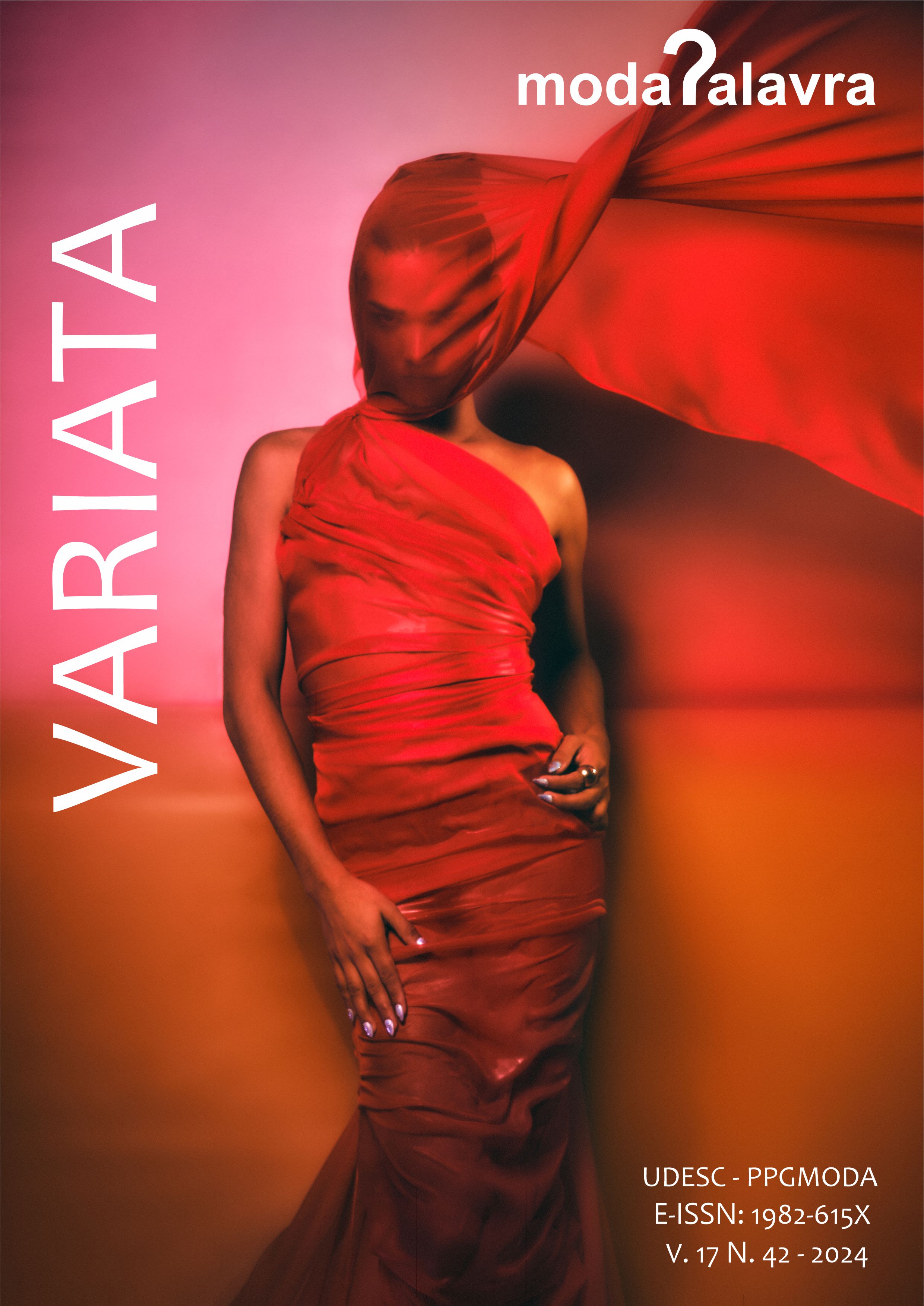The fictional body in fashion: emotion as a diegetic strategy for costume designs
DOI:
https://doi.org/10.5965/1982615x17422024e0010Keywords:
fashion, film analysis, fictional narrativeAbstract
Fashion indicates ways of life and inspires changes in behavior, consumption and in the various material structures that circumscribe human existence, particularly the relationship between body and clothing. Therefore, social and emotional complementarity is assumed, awakened through symbolic systems. The socially integrated body assimilates the symbolism of the collective in which it is inserted, a precursor situation of differences and social bond. Symbolic assumptions are also justified in audiovisual productions, which seek to represent different meanings and experiences. This article aims to understand the translations between these two poles: culturally clothed body and diegetic effects of costumes. A qualitative work that, through film analysis, decomposes the narrative strategies in the dramatic structure of the miniseries Transatlântico (Netflix, 2023). To do so, it uses a bibliographic review of the field of fashion in clothing and the scope of socially instituted sensibilities, in order to link effects and consequences of these to audiovisual production.
Downloads
References
BARNARD, M. Moda e Comunicação. Rio de Janeiro: Rocco, 2005.
BARTHES, R. Sistema da Moda. São Paulo: WMF Martins Fontes, 2009.
BORDWELL, D.; THOMPSON, K. Arte no Cinema: uma introdução. Campinas, SP: Editora da Unicamp; São Paulo, SP: Editora da USP, 2013.
BRETON, A. Manifesto Surrealista (1924). academia.edu. Disponível no link: https://www.academia.edu/29330495/Manifesto_do_Surrealismo_Andre_Breton. Acesso em: 25 junho. 2023.
CALANCA, D. História Social da Moda. Tradução de Renato Ambrosio. São Paulo: Editora Senac, 2011.
COELHO, M. C.; REZENDE, C. B. Cultura e sentimentos: ensaios em antropologia das emoções. Rio de Janeiro: Contra Capa, FAPERJ, 2011.
CRANE, D. A moda e seu papel social: classe, gênero e seu papel social. São Paulo: Senac, 2006.
FARTHING, S. Tudo sobre arte. Rio de Janeiro: Sextante, 2011.
GIL, I. A atmosfera como figura fílmica. Actas do III Sopcom, VI Lusocom e II Ibérico, v. 1, 2005.
HAMBURGER, V. Arte em cena: a direção de arte no cinema brasileiro. São Paulo: Edições Senac, 2014.
OLIVEIRA, A. C. de. Corpo, roupa, moda nas inter-relações semióticas da comunicação. Dobra[s] – revista da Associação Brasileira de Estudos de Pesquisas em Moda, v. 3, n. 6, p. 58–72, 2009. Disponível em: https://dobras.emnuvens.com.br/dobras/article/view/288. Acesso em: 3 maio. 2023.
KATZ, H. Por uma teoria crítica do corpo. in: OLIVEIRA, Ana Claudia; CASTILHO, Kathia. Corpo e Moda: por uma compreensão do contemporâneo. Barueri, SP: Estação das Letras e Cores Editora, 2008.
LE BRETON, D. Antropologia das Emoções. Petrópolis, RJ: Vozes, 2019.
LEITE, A.; GUERRA, L. Figurino: uma experiência na televisão. São Paulo: Paz e Terra, 2002.
LIPOVETSKY, G. O império do efêmero. São Paulo: Companhia das Letras, 2009.
MOURA, C. B.i de. A direcão e a direcão de arte: construcões poéticas da imagem em Luiz Fernando Carvalho. Tese (Doutorado) - PPGAC - ECA/USP, 2015.
SAFATLE, V. O circuito dos afetos: corpos políticos, desamparo e o fim do indivíduo. Belo Horizonte: Autêntica Editora, 2019.
SANTAELLA, L. Corpo e comunicação. São Paulo: Paulus, 2004.
SIMMEL, G. A moda (Die Mode, in: Philosophische Kultur, 1911). Tradução de Antonio Carlos Santos. IARA – Revista de Moda, Cultura e Arte. V.1 N. 1 abr./ago. Senac: São Paulo, 2008a. Disponível no link: https://www2.ufjf.br/posmoda//files/2008/07/07_IARA_Simmel_versao_final.pdf. Acesso em 12 de junho de 2023.
SIMMEL, G. Filosofia da moda e outros escritos. Lisboa: Edições Texto & Grafia, 2008b.
SODRÉ, M. As estratégias sensíveis: afeto, mídia e política. Rio de Janeiro: Mauad X, 2016.
SVENDSEN, L. Moda: uma filosofia. Tradução de Maria Luiza X. de A. Borges. Rio de Janeiro: Zahar, 2010.
TAMBINI, M. O design do século. São Paulo: Ática, 1999.
VASCONCELOS, F. Moda e criatividade ajudam a escapar dos nazistas em ‘Transatlantic’. in: site PLU7, junho de 2023. Disponível no link: https://plu7.com/88253/entretenimento/moda-e-criatividade-ajudam-a-escapar-dos-nazistas-em-transatlantic/. Acesso em 01 de junho de 2023.
VANOYE, F.; GOLIOT-LÉTÉ, A. Ensaio sobre a análise fílmica. Papirus Editora, 2012.
Published
How to Cite
Issue
Section
License
Copyright (c) 2024 Patrícia Azambuja, Ramon Bezerra Costa

This work is licensed under a Creative Commons Attribution-NonCommercial 4.0 International License.
When submitting an article for publication in ModaPalavra e-periodico, the author (s) agree (s) with the following terms:
- Authors maintain the copyright in their manuscripts and grant the journal the right of first publication, with work simultaneously licensed under the Creative Commons Attribution-NonCommercial 4.0 International, which allows sharing the work with the acknowledgment of authorship and the initial publication in the journal without payment ;
- Authors may use the same results in other publications after the first publication, provided that they indicate ModaPalavra e-journal as the original publication medium;
- Authors are authorized to take additional contracts, separately, only after the original publication in ModaPalavra e-journal, provided they indicate ModaPalavra e-journal as the original publication medium;
- Authors are allowed and encouraged to publish and distribute their work online (eg in institutional repositories or on their personal page), only after the editorial process and the first publication, provided they indicate ModaPalavra e-journal as the original publication medium;
- To indicate ModaPalavra e-journal as the original publication medium, authors should use the following text template: "This article was originally published by ModaPalavra e-periodical, under a CC BY NC license, in its volume [insert volume] number [insert number] in the year of [insert year], and can be accessed at: http://www.revistas.udesc.br/index.php/modapalavra/ ";
- The opinions expressed in the articles are the author’s sole responsibility, not necessarily reflecting the journal’s opinion. The publication of any material that is owned and held in copyright by a third party, including – but not limited to - articles, photos or drawings was previously authorized by their representatives to be published in ModaPalavra e-journal.









